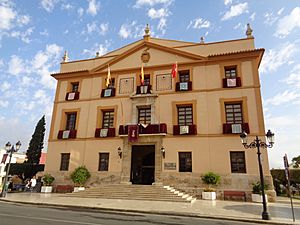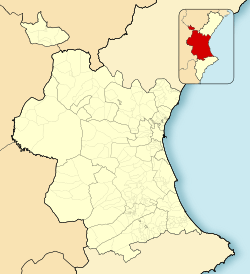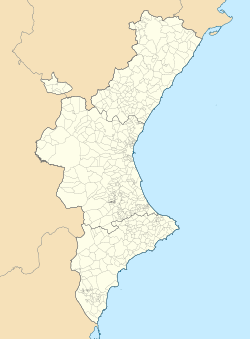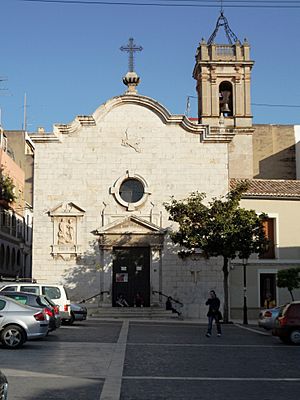Paterna facts for kids
Quick facts for kids
Paterna
|
|||
|---|---|---|---|

Palacio de los Condes de Villapaterna, seat of the municipal government of Paterna.
|
|||
|
|||
| Country | |||
| Autonomous community | |||
| Province | Valencia | ||
| Comarca | Horta Oest | ||
| Judicial district | Paterna | ||
| Area | |||
| • Total | 44.0 km2 (17.0 sq mi) | ||
| Elevation | 70 m (230 ft) | ||
| Population
(2018)
|
|||
| • Total | 69,156 | ||
| • Density | 1,571.7/km2 (4,071/sq mi) | ||
| Demonym(s) | Paternero (m) Paternera (f) | ||
| Time zone | UTC+1 (CET) | ||
| • Summer (DST) | UTC+2 (CEST) | ||
| Postal code |
46980
|
||
| Official language(s) | Valencian, Spanish | ||
Paterna is a city and a municipality in the province of Valencia in the Valencian Community, Spain. It is located about 5 kilometers (3 miles) northwest of the city of Valencia. The city sits on the left bank of the Turia River. In 2014, Paterna had 67,156 people living there. This made it the eleventh largest city by population in the Valencian Community.
Contents
What's the Weather Like?
Paterna has a dry Mediterranean climate. This means it has hot, dry summers and mild, wet winters. The average yearly rainfall is around 400 millimeters (16 inches).
Temperatures usually range from 5°C (41°F) in January to 32°C (90°F) in August. Sometimes, in summer, temperatures can go above 40°C (104°F).
A Look Back in Time: History
The first signs of people living in Paterna go way back to the Neolithic (New Stone Age) and Bronze Age. Tools and other items have been found in areas like The Vallesa and Despeñaperros. These places are small hills near the Turia River, which provided water.
The Iberians, an ancient people of Spain, also lived here. They left behind parts of a defensive wall and small huts in The Vallesa and Despeñaperros.
Roman Times
When the Romans arrived, the name "Paterna" likely came from the Latin word "Paternus." This word means "belonging to the father," suggesting it was someone's property. Remains of a Roman aqueduct, a system for carrying water, have been found here.
In 2009, during an excavation for new houses, ruins of a Roman villa were discovered. This villa was from the 1st to 3rd centuries. It was the first sign of a Roman home found between Valencia and Llíria.
Middle Ages and Beyond
During the Moslem period, Paterna became known for its pottery and farming. New ways of watering land were introduced, and crops like rice and oranges were grown. In 1237, King James I of Aragon peacefully entered the Paterna area.
The land of Paterna was given to Artal de Luna, a knight who helped write the laws of Valencia. The Luna family were the lords of Paterna from the 13th to the 15th century. This was a time when Paterna's pottery was very popular.
Later, in the 16th century, pottery production and the local economy faced problems. The Expulsion of the Moriscos, which forced the Muslim population to leave, caused Paterna to lose many people. This led to a period of economic slowdown.
Modern Times
In the 19th century, farming started to grow again. The first cave-houses were built. Important improvements were made, like a water pipeline in 1866 and a new City Hall in 1881.
In 1888, a narrow-gauge railway was built, connecting Paterna to Valencia and Llíria. This made travel much easier. The city began to grow as people moved in, and new neighborhoods were built.
In the 20th century, the creation of the Polígono Fuente del Jarro industrial area brought many jobs. This attracted more people to Paterna, changing its economy and how the city looked.
How Many People Live Here?
In 1900, Paterna had about 3,505 residents. Between 1950 and 1970, the new industrial area, Polígono Fuente del Jarro, led to a big increase in population. The number of people living in Paterna tripled.
Today, Paterna continues to grow because of new homes and expanding industrial areas. In 2014, the population was 67,156 people.
Neighborhoods and Districts
Paterna has several main areas. These include the Urban Center (with areas like Center, Alborgí, Campament, Santa Rita), La Canyada, Mas del Rosary, Terramelar, Lloma Llarga (Valterna), and Bobalar.
The city also has four important industrial parks: Fuente del Jarro, Tactica, L'Andana, and Parque Tecnológico.
What's the Economy Like?
The service sector, which includes jobs like retail and healthcare, makes up 56% of Paterna's economy. Industry accounts for 33.2%, construction for 9.8%, and agriculture for 1%.
Paterna is a major industrial hub in southern Europe. It is home to several large industrial areas and business parks. These include Fuente del Jarro, L'Andana, Tactica, and the Technological Park of Valencia.
The industries in Paterna are very diverse. They produce food, textiles, wood, leather, metal, chemicals, plastics, and transportation equipment.
Paterna Ceramics
In the Middle Ages and the Renaissance, Paterna was a very important center for making ceramics in Spain. Its pottery was sold all over the Mediterranean region. Famous pieces include plates, bowls, and pharmacy jars decorated with blue and gold, or green and manganese colors. The designs often featured people, animals, plants, or family symbols.
The socarrat (from the 15th century) is a special type of Paterna pottery. These are rectangular clay pieces used to decorate palaces and mansions, especially on eaves and ceilings.
You can see a large collection of these ceramics at the Museum of Ceramics in Paterna. Paterna's ceramic pieces are also displayed in famous museums around the world, including the National Archaeological Museum of Spain in Madrid, and museums in Valencia, Barcelona, Paris, London, and New York.
Getting Around: Transportation
Paterna is well-connected by major roads:
- The A-7 highway links to other cities along the Mediterranean coast.
- The A-3 highway connects to Madrid.
- The V-30 highway leads to the Port of Valencia.
- The CV-35 highway goes into the province of Valencia.
- Valencia Airport in Manises is nearby.
Public Transport
- Paterna Municipal Transportation: Paterna has its own bus network with 10 lines. These buses connect different neighborhoods, industrial parks, schools, and the Technology Park. Paterna Municipal Transportation
- Interurban Bus: Buses connect Paterna (line 140) and the Technology Park (line 130) to Valencia. Edetania Bus
- Valencia Metro: Subway line 1 has stops in Paterna at Campament, Paterna, Santa Rita, Fuente del Jarro, La Canyada, and La Vallesa. Tram line 4 stops at À Punt, Lloma Llarga-Terramelar, Parc Cientific, Tomás y Valiente, La Coma, and Mas del Rosari. Both lines connect to Valencia.
Cool Places to See: Patrimony
- The Tower of Paterna: This tower is from the Arab period. It was used for defense because it was in a great spot with clear views of the area. It is round, about 19.5 meters (64 feet) tall, and 9.6 to 12.7 meters (31 to 42 feet) wide.
- Counts of Villapaterna Palace: This grand palace was built in 1760. In 1983, the city council bought it, and it now serves as the city hall.
- Calvary: This area has a terrace with views of the Turia River and nearby towns. The town clock is located here. Long ago, the Castle of Paterna stood on this spot, but it was taken down in the 18th century.
- Ceramics Museum: Located in the old town hall, this museum has one of the most important collections of ceramics from Valencia.
- Church of St. Peter: Built in the 14th century where a mosque once stood. It was updated in the 18th century.
- Antonio Ferrandis Grand Theatre: Built in the late 1920s, this theater was a popular place for entertainment. The city bought it and reopened it in 2000, naming it after the famous actor Antonio Ferrandis Monroy, who was from Paterna. It hosts many cultural events.
- Capri Theatre: Built in 1924, this theater was also bought and reopened by the city in 2000. It now hosts cultural events and is used by local theater groups for practice.
- The Large Cave Cultural Space: This area includes an amphitheater and the central library. It is part of The Tower and Caves Park.
- Caves of Fuller Cultural Space: These caves are used to host art exhibitions, offering a unique and historic setting.
- Paterna Mills: These mills were built in the Middle Ages. They used the power of water from the Moncada canal to grind flour and rice, and to produce textiles. By the late 19th century, Paterna became the biggest flour producer in Valencia. Over time, new technologies led to these mills being used less.
- Turia River Natural Park: The largest natural area in Paterna is The Vallesa Forest, located near the Turia River. It has many pine trees and typical Mediterranean plants like rosemary, oak, and gorse.
- Ridge of Betxí: An ancient Bronze Age settlement found in the Vallesa of Mandor area.
- Observatory of the University of Valencia
- Campus Burjassot-Paterna Science Park
- Ciudad Deportiva Valencia CF: This is the training ground and facility for the famous football club Valencia CF.
In May 2000, the city of Paterna was recognized as a place of tourist interest by the regional government, the Generalitat Valenciana.
Learning and Fun: Education and Culture
The Lycée Français de Valence (LFV), which is a French international school for Valencia, is located in Paterna.
Festivals
- Falles: This festival is held every March.
- Moors and Christians and La Cordà (The Rope): La Cordà is the exciting end to the festival, happening on the morning after the last Sunday in August. It's a fireworks event that takes place on Main Street. Shooters, led by the Mayor Fireworks, light 50,000 rockets, with about 2,000 rockets going off every minute! Both professional and amateur shooters can also set off rockets in a special area called the cohetódromo during the main festivals. Other fireworks displays, like the Rocket House Parade and Correfoc dels Dimonis, also happen around La Cordà.
Gastronomy
Besides the typical foods of the Valencia area, like paella and rice dishes, Paterna is famous for its cachap. This is a sweet pastry filled with a special cream that is unique to Paterna.
Sister Cities
Paterna has "sister city" relationships with other cities around the world. This means they share cultural and educational ties.
Famous People
- Antonio Ferrandis (1921–2000), a well-known actor.
See also
 In Spanish: Paterna para niños
In Spanish: Paterna para niños









